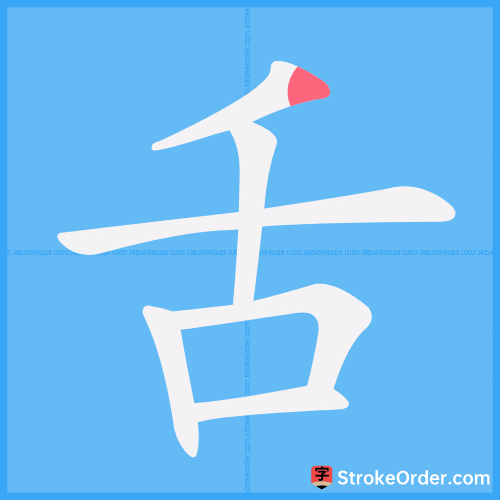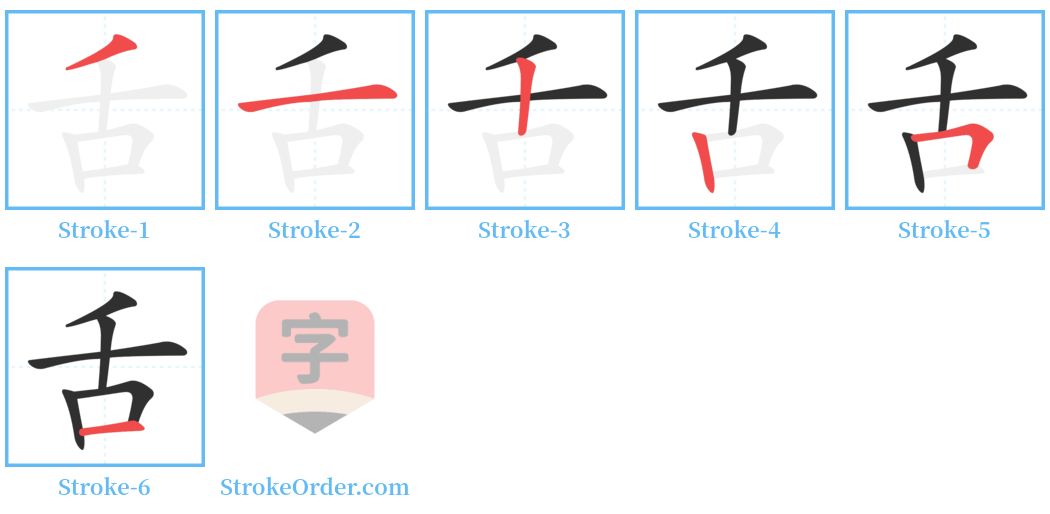舌 Stroke Order
Animated Stroke Order of 舌

Stroke Order Diagrams for 舌

Step-by-Step Handwriting Guide for 舌

Learn to Write Chinese Characters with Video Tutorials
Watch the video of writing the Chinese character "舌", learn the correct stroke order (笔顺) of the character "舌", and master the standard way of writing the character "舌".
Free Printable Handwriting Practice with Stroke Order: 舌
Printable Writing Practice Worksheet of "舌" in Portrait Orientation (Tian Zi Ge)

Printable Writing Practice Worksheet of "舌" in Landscape Orientation (Tian Zi Ge)

Information of 舌
Pinyin
shé
Radical
舌
Strokes
6 strokes
Usage
★★★★★
Definition
tongue
舌 [shé]
(名)
【本义】舌头
1. 人或动物嘴里辨别滋味、帮助咀嚼和发音的器官:
Tongue: the organ in humans or animals used to distinguish tastes, assist in chewing, and produce sounds.
例:舌头(tongue),舌耕(a. indicates diligent study; b. in ancient times, scholars relied on speaking for a living)。唇枪舌剑(sharp words, verbal sparring)。
2. 语言辩论的代称:
Language: a metaphor for language or debate.
例:舌战(fierce debate)。
3. 像舌头的东西:
Something resembling a tongue.
例:帽舌(the part of a hat that resembles a tongue),火舌(flame tongue)。
4. 铃或释中的锤:
Hammer: a hammer found inside bells or certain instruments.
例:指装在铃铎内的锤(the hammer inside a bell)。
5. 指箭靶两旁上下伸出的部分:
Part of an archery target: the parts that extend up and down on both sides of an archery target.
【引】
1. 《说文》:舌,在口所以言也,别味也。从干,从口。言犯口而出,食犯口而入也。
"In Shuowen, it is stated that the tongue is for speech and distinguishes flavors, composed of ‘dry’ and ‘mouth’."
2. 《易·说卦》:兑为口舌。
"In the Book of Changes, it refers to the mouth and tongue."
3. 《素问·阴阳应象大论》:心在窍为舌。
"In Suwen, it mentions that the mind is through the holes of the tongue."
4. 《虞初新志·秋声诗自序》:人有百口,口有百舌,不能名其一处也。
"In Yu Chuxin's writings, it says that people have a hundred mouths and a hundred tongues, yet cannot name a single one."
【例】
1. 舌举(舌翘起而不能动,指理屈词穷)
2. 舌挢不下(翘起舌头,形容惊讶或害怕的样子)
3. 舌刺刺(嘴舌不停地说)
4. 舌敞唇穿(舌头干裂,嘴唇焦干,形容说很多话)
5. 舌干唇焦(唇焦裂,描述费尽口舌、反复劝说)
Input Method for 舌
Pinyin
she2
Wubi
tdd
Cangjie
hjr
Zhengma
mi
Four Corner
20604
Unicode
U+820c
Same Pronunciation Characters